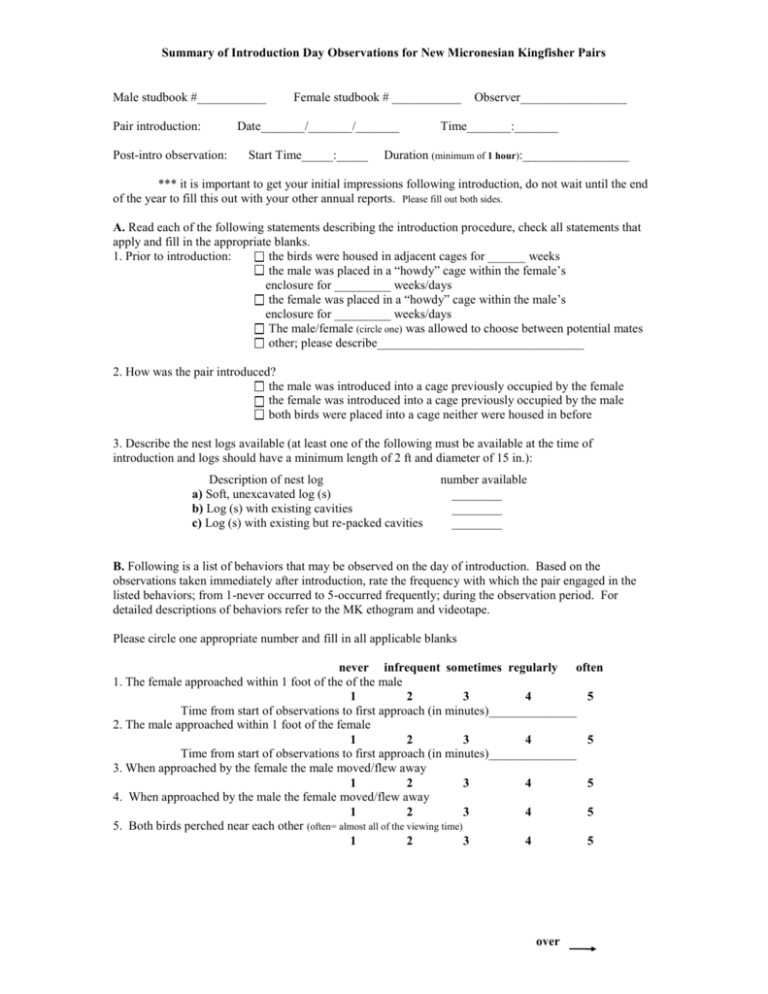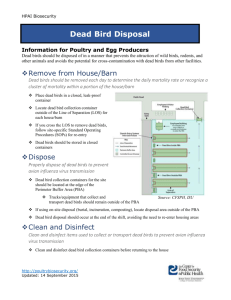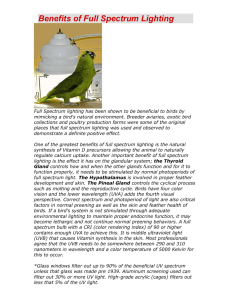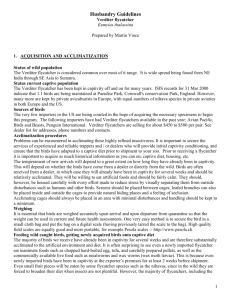Male studbook
advertisement

Summary of Introduction Day Observations for New Micronesian Kingfisher Pairs Male studbook #___________ Pair introduction: Post-intro observation: Female studbook # ___________ Date_______/_______/_______ Start Time_____:_____ Observer_________________ Time_______:_______ Duration (minimum of 1 hour):_________________ *** it is important to get your initial impressions following introduction, do not wait until the end of the year to fill this out with your other annual reports. Please fill out both sides. A. Read each of the following statements describing the introduction procedure, check all statements that apply and fill in the appropriate blanks. 1. Prior to introduction: the birds were housed in adjacent cages for ______ weeks the male was placed in a “howdy” cage within the female’s enclosure for _________ weeks/days the female was placed in a “howdy” cage within the male’s enclosure for _________ weeks/days The male/female (circle one) was allowed to choose between potential mates other; please describe_________________________________ 2. How was the pair introduced? the male was introduced into a cage previously occupied by the female the female was introduced into a cage previously occupied by the male both birds were placed into a cage neither were housed in before 3. Describe the nest logs available (at least one of the following must be available at the time of introduction and logs should have a minimum length of 2 ft and diameter of 15 in.): Description of nest log a) Soft, unexcavated log (s) b) Log (s) with existing cavities c) Log (s) with existing but re-packed cavities number available ________ ________ ________ B. Following is a list of behaviors that may be observed on the day of introduction. Based on the observations taken immediately after introduction, rate the frequency with which the pair engaged in the listed behaviors; from 1-never occurred to 5-occurred frequently; during the observation period. For detailed descriptions of behaviors refer to the MK ethogram and videotape. Please circle one appropriate number and fill in all applicable blanks never infrequent sometimes regularly often 1. The female approached within 1 foot of the of the male 1 2 3 4 5 Time from start of observations to first approach (in minutes)______________ 2. The male approached within 1 foot of the female 1 2 3 4 5 Time from start of observations to first approach (in minutes)______________ 3. When approached by the female the male moved/flew away 1 2 3 4 5 4. When approached by the male the female moved/flew away 1 2 3 4 5 5. Both birds perched near each other (often= almost all of the viewing time) 1 2 3 4 5 over never infrequent sometimes regularly often 6. The birds were observed drilling, making contact with or inside the nest log 1 2 3 4 5 Which bird (circle one or both)? M F Time from start of observations to first nest activity______________________ 7. Barking vocalizations were heard 1 2 3 4 5 The vocalizing bird (s) was (circle one or both): M F 8. Pair vocalizations were heard 1 2 3 4 5 The vocalizing bird (s) was (circle one or both): M F C. Indicate which, if any, of the following behaviors were observed (yes or no) and by which bird (male, female or both). Circle all appropriate responses 1. 2. 3. 4. 5. 6. One bird attacked the other The birds engaged in bill sparring The birds were observed to fight One bird gave a threat display to the other The male offered food to the female The male mounted/copulated with the female 7. The birds were observed to eat 8. Aggression occurred over food Y Y Y Y Y Y N N N N N N Y Y N N if yes, the aggressor was M F if yes, the aggressor was M F if yes, the aggressor was M F if yes, the aggressor was M F if yes, what food item?_________ if yes, did it appear that cloacal contact was made? Y N if yes, M F D. Based on your observations of this pair and your previous experience with other pairs, please rate the following statements. What is your opinion regarding the behavior of this pair? (circle one appropriate number) strongly disagree disagree agree strongly not agree sure not applicable (no prior exp.) 1. This pair appears very compatible 1 2 3 4 5 2. This pair appears highly motivated to engage in reproductive behavior 1 2 3 4 5 3. These birds do not appear interested/aware of each other 1 2 3 4 5 4. There appears to be some “tension” between these birds 1 2 3 4 5 5. This pair is very active 1 2 3 4 5 6. This pair is very vocal 1 2 3 4 5 7. The behavior of this pair is very similar to other reproductive pairs I have observed 1 2 3 4 5 8. The behavior of this pair is very similar to other pairs that were incompatible 1 2 3 4 5 NA NA NA NA NA NA NA NA E. Additional Comments (use additional sheets if necessary): Return this form to: Beth Bahner, Micronesian Kingfisher Species Coordinator, Philadelphia Zoological Garden, 3400 W. Girard Ave., Phila. PA. 19104, FAX: 215-243-0219 Appendix C (cont.) Instructions for introduction day observations (see Husbandry Manual Chapter 6 for additional information regarding pair introductions): 1. 2. 3. Be prepared to observe the pair for at least 90 minutes following introduction. Read the Summary Form before your observations to be sure that you will be able to answer all relevant questions. If your observations last longer than 90 minutes, use only the first 90 minutes of observation to answer the questions on the summary form. If important behavior occured after this first hour, summarize these on a separate piece of paper. Based on a small sample of newly paired birds, it appears that pairs displaying a particular combination of behaviors within a short period after introduction are more likely to be sexually compatible than pairs in which these behaviors are absent. Your observations will help to determine if this techinique can be used to accurately assess reproductive potential in order to make more timely management decisions. For this reason, it is important to standardize the methods as much as possible. Although all behavior should be recorded to the best of your ability during your observations, certain behaviors are of particular importance. Be sure to record all instances of nest activity and which (male, female, both) of the birds directed their activity towards the nest. [note remember to be sure that at least one potential nest log is available at the time of introduction] In addition, record the amount of time it took before one bird approached the other (latency to approach) and the total amount of the observation time that the pair sat in close proximity (within one foot). Lastly, record all aggressive interactions and the severity of those interactions; mild (beak gape, crown erect, brief bill sparring), moderate (displacement, dive bombing, staring) or severe (fights, full threat displays, attacks). Your overall impressions about the compatibility of the pairs is also very important since this will enable us to determine the accuracy of keeper assessments (e.g., on pair activity forms) for predicting the reproductive potential of a pair.








